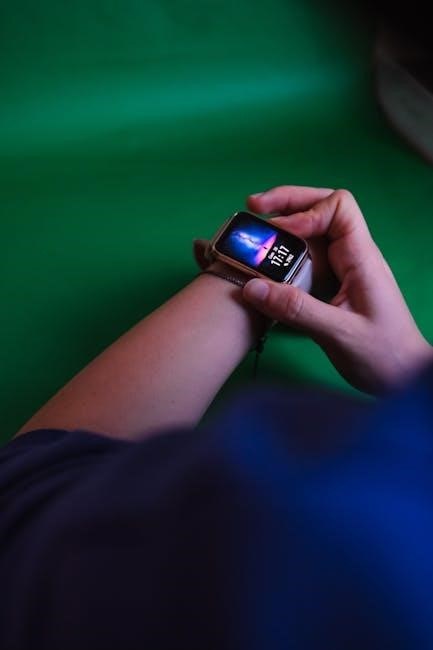A smartwatch is a wearable device combining timekeeping with advanced features like fitness tracking‚ notifications‚ and app integration. It enhances daily convenience and promotes an active lifestyle.
1.1 What is a Smartwatch?
A smartwatch is a wearable device that combines traditional watch functionality with advanced smartphone-like features. It typically includes a touchscreen‚ fitness tracking‚ heart rate monitoring‚ and app integration. Designed to pair with smartphones via Bluetooth or Wi-Fi‚ smartwatches offer notifications‚ voice commands‚ and customizable watch faces. They serve as both fashion accessories and tools for health‚ productivity‚ and entertainment‚ catering to diverse lifestyles and preferences.
1.2 Evolution of Smartwatches
Smartwatches have evolved significantly since their debut in the 1970s‚ starting as simple calculator watches. In the 1990s‚ they incorporated basic fitness tracking. The 2010s saw the rise of modern smartwatches with touchscreens‚ app support‚ and health monitoring. The Apple Watch in 2015 revolutionized the market‚ introducing advanced features like heart rate monitoring and integration with smartphones. Today‚ smartwatches offer GPS‚ voice assistants‚ and customizable faces‚ blending style with functionality. They’ve become essential tools for fitness‚ productivity‚ and connectivity on the go.
1.3 Benefits of Using a Smartwatch
A smartwatch offers convenience‚ enhances productivity‚ and supports health goals. It allows users to receive notifications‚ control music‚ and access apps directly from the wrist. Fitness enthusiasts benefit from activity tracking‚ heart rate monitoring‚ and workout apps. Smartwatches also provide navigation‚ voice assistant support‚ and customizable watch faces. They serve as a stylish accessory while integrating seamlessly with smartphones‚ making them ideal for individuals seeking a blend of functionality‚ health monitoring‚ and personal style in their daily lives.

Setting Up Your Smartwatch
Start with unboxing and physical setup‚ then pair your smartwatch with a smartphone. Complete initial configuration and syncing to ensure all features are ready for use.
2.1 Unboxing and Physical Setup
Unboxing your smartwatch reveals the device‚ charger‚ and bands. Ensure all components are included and undamaged. To set up‚ turn on the watch by pressing the side button. Adjust the band for a snug‚ comfortable fit. Familiarize yourself with the buttons and screen layout. Clean the display with a soft cloth to remove fingerprints. Charge the watch immediately to ensure proper functionality. If included‚ attach additional straps or accessories as per the manufacturer’s instructions. Proper physical setup ensures optimal performance and user experience.
2.2 Pairing with a Smartphone
To pair your smartwatch with a smartphone‚ ensure both devices are turned on and Bluetooth is enabled. For Apple Watch‚ bring your iPhone near the watch and follow the on-screen instructions. Android users may need to open the Wear OS app and select their device from the available list. If pairing fails‚ restart both devices or forget the device in Bluetooth settings and retry. Successful pairing allows syncing notifications‚ apps‚ and health data‚ ensuring a seamless connected experience between your smartwatch and smartphone.
2.3 Initial Configuration and Syncing
After pairing‚ configure your smartwatch by selecting preferences like watch faces and notification settings. Syncing involves transferring data from your smartphone‚ such as contacts and apps. For Apple Watch‚ use the Watch app on your iPhone to customize settings and install apps. Ensure your watch and phone are connected via Bluetooth or Wi-Fi for seamless syncing. This initial setup ensures your smartwatch is tailored to your needs‚ providing a personalized experience for fitness tracking‚ notifications‚ and app functionality. Regular syncing keeps your data up-to-date and optimized for performance.

Navigating the Smartwatch Interface
Navigate your smartwatch using intuitive touch gestures‚ voice commands‚ and the home screen. Swipe‚ tap‚ or use the digital crown for easy access to apps and settings.
3.1 Understanding the Home Screen
The home screen is your gateway to essential features and apps. Customize it by pressing firmly to choose complications‚ adding frequently used apps for quick access. Notifications appear with a swipe down‚ while the digital crown scrolls through lists. Widgets provide glanceable information‚ and voice commands offer hands-free navigation; Tailor your home screen to fit your lifestyle‚ ensuring a seamless and personalized user experience with just a glance or tap.
3.2 Using Touch Gestures
Touch gestures are the primary way to navigate your smartwatch. Swipe up to view notifications‚ left or right to switch between screens‚ and down to dismiss or return. Tap firmly (Force Touch) on the screen to access additional options or customize the watch face. Double-tapping wakes the screen‚ while covering it with your palm puts it to sleep. These intuitive gestures allow you to efficiently manage apps‚ check updates‚ and interact with features without complication‚ enhancing your overall smartwatch experience.
3.3 Voice Commands and Siri/Google Assistant
Smartwatches support voice commands through Siri or Google Assistant‚ enabling hands-free control. Raise your wrist and speak to perform tasks like setting reminders‚ sending messages‚ or starting workouts. Siri allows quick access to Apple services‚ while Google Assistant integrates seamlessly with Android systems. Voice commands simplify navigation‚ letting you manage apps‚ play music‚ or get directions without touching the screen. This feature enhances convenience and accessibility‚ making your smartwatch experience more intuitive and efficient for daily use.

Customizing Your Smartwatch
Personalize your smartwatch by changing watch faces‚ downloading apps‚ and adjusting notification settings to suit your preferences and lifestyle for enhanced functionality.
4.1 Changing Watch Faces
To customize your smartwatch‚ press firmly on the watch face to access customization options. Swipe through available faces or sync new ones from your iPhone. Choose designs that match your style or add complications for quick access to apps like fitness trackers or calendars. This feature allows personalization‚ enhancing both aesthetics and functionality. Use the Settings app or the Apple Watch app on your iPhone to explore and download additional faces‚ ensuring your watch reflects your unique preferences and needs.
4.2 Managing and Downloading Apps
Managing apps on your smartwatch is straightforward. Open the Apple Watch app on your iPhone‚ navigate to the App Store section‚ and browse or search for apps. To download‚ tap Get and wait for the app to sync with your watch. Organize apps by selecting Grid View or List View on your watch. You can also delete unused apps directly from the watch face by pressing firmly and selecting Edit Apps. This helps keep your interface clutter-free and ensures easy access to frequently used apps.
4.3 Adjusting Notification Settings
To customize notifications on your smartwatch‚ open the Apple Watch app on your iPhone and navigate to Notifications. Here‚ you can enable or disable notifications for specific apps. On your watch‚ swipe down from the top of the screen to view notifications. Firmly press the screen to customize notification privacy or dismiss them. You can also mute notifications during specific times using Do Not Disturb mode. Adjusting these settings ensures you receive only important alerts‚ enhancing your overall smartwatch experience.

Health and Fitness Features
Smartwatches offer advanced health and fitness tools‚ including activity tracking‚ heart rate monitoring‚ and exercise tracking. They also provide built-in GPS for precise distance tracking during workouts.
5.1 Activity Tracking and Fitness Goals
Smartwatches like the Apple Watch include an Activity app that tracks daily steps‚ calories burned‚ and exercise minutes. Users can set and adjust fitness goals‚ such as Move targets‚ to stay motivated; The watch automatically detects exercises like running or swimming and logs progress. Notifications remind users to move or complete their goals. This feature helps users maintain an active lifestyle and achieve their health objectives effectively‚ with customizable options to suit individual needs and preferences for a personalized fitness journey.
5.2 Heart Rate and Health Monitoring
Smartwatches like the Apple Watch feature built-in heart rate monitoring‚ providing real-time data throughout the day. They can detect irregular rhythms and alert users to potential heart health issues. Additionally‚ fall detection and emergency SOS features ensure user safety. The watch also monitors environmental sound levels to protect hearing. These health tools offer comprehensive insights‚ enabling users to track their well-being and receive timely notifications for critical health metrics‚ promoting proactive health management and peace of mind.
5.3 Exercise Tracking and Workout Apps
Smartwatches offer robust exercise tracking‚ monitoring activities like running‚ swimming‚ and cycling. The Activity app on Apple Watch logs workouts‚ sets goals‚ and rewards progress. Users can track calories burned‚ distance‚ and exercise minutes. The watch automatically detects workouts‚ ensuring accurate logging. Built-in GPS provides precise distance tracking for outdoor activities. Additionally‚ third-party apps like Nike Training Club offer guided workouts. Real-time feedback helps users optimize their routines‚ making it easier to reach fitness goals and maintain an active lifestyle with personalized tracking and motivation.

Managing Battery Life
Smartwatches require careful battery management. Tips include lowering screen brightness‚ disabling unnecessary notifications‚ and using Power Reserve mode. Regular charging and avoiding overnight charging can extend battery life.
6.1 Tips for Conserving Battery
To extend your smartwatch’s battery life‚ consider these tips:
- Lower screen brightness and disable Always-On Display.
- Turn off unnecessary notifications and background app refresh.
- Limit the use of GPS and location services.
- Enable Power Reserve mode during extended periods of inactivity.
- Avoid overcharging‚ as it can degrade battery health over time.
These simple adjustments can significantly enhance your smartwatch’s battery performance and longevity.
6.2 Understanding Power Reserve Mode
Power Reserve Mode is a feature designed to extend your smartwatch’s battery life during low-power conditions. When enabled‚ it disables non-essential functions‚ leaving only basic timekeeping active. This mode is ideal for preserving battery when you’re unable to charge your watch for an extended period. You can manually activate Power Reserve Mode through the Settings app or by swiping up from the watch face and holding. Once activated‚ your watch will display only the time‚ significantly reducing battery consumption and extending usage for several additional days. This feature is particularly useful for long trips or situations where charging isn’t feasible.
6.3 Charging Your Smartwatch
To charge your smartwatch‚ place it on the wireless charger or use the provided Magnetic Charging Cable. Ensure the watch is properly aligned with the charger. The device will confirm charging with a visual or auditory cue. Charging typically takes about 2 hours for a full battery. For optimal performance‚ use the original charger and avoid overcharging. If the battery is critically low‚ enable Power Reserve Mode to extend usage while charging. Always follow safety guidelines to maintain your smartwatch’s longevity and performance.

Connectivity and Compatibility
Smartwatches connect to smartphones via Bluetooth or Wi-Fi‚ ensuring seamless integration. Compatibility varies across devices‚ with models optimized for specific ecosystems like Apple or Android.
7.1 Bluetooth and Wi-Fi Connectivity
Bluetooth and Wi-Fi connectivity enable smartwatches to pair with smartphones and access the internet. Bluetooth ensures a stable‚ low-power connection for notifications and music control‚ while Wi-Fi allows direct internet access for apps and updates. Common issues include pairing problems‚ which can be resolved by restarting devices or resetting network settings. Troubleshooting steps like forgetting the device in Bluetooth settings and re-pairing often fix connectivity problems. Proper connectivity is crucial for maximizing smartwatch functionality and ensuring seamless integration with paired devices;
7.2 Compatibility with Different Smartphones
Smartwatches are designed to work with various smartphones‚ primarily through Bluetooth or Wi-Fi. Apple Watches are exclusively compatible with iPhones running iOS 8.2 or later‚ while Wear OS watches support both Android and iOS devices‚ though some features may be limited on iPhones. Compatibility issues can arise‚ but restarting devices‚ unpairing‚ and re-pairing often resolve connectivity problems. Ensure your smartphone meets the smartwatch’s minimum OS requirements for seamless functionality. Always check the manufacturer’s guidelines for specific compatibility details to avoid pairing issues.
7.3 Water Resistance and Durability
Smartwatches often feature water resistance‚ making them suitable for swimming and water activities. The Apple Watch‚ for instance‚ offers water resistance up to 50 meters‚ ideal for swimming. Durability varies by model‚ with materials like stainless steel or aluminum providing robust protection. Regular maintenance‚ such as cleaning and avoiding harsh chemicals‚ ensures longevity. Always check the manufacturer’s guidelines for specific water resistance ratings and care tips to maintain your smartwatch’s performance and extend its lifespan effectively.
Advanced Features
Smartwatches offer advanced features like built-in GPS for navigation‚ integration with other devices‚ and enhanced security settings to protect user data and ensure privacy.
8.1 Built-in GPS and Navigation
Built-in GPS enables precise location tracking‚ route mapping‚ and distance measurement during activities like running or cycling. This feature allows users to navigate without their smartphone‚ ensuring accurate workout tracking and exploration. GPS data syncs with fitness apps‚ providing detailed analytics for performance improvement. Additionally‚ turn-by-turn directions assist in unfamiliar territories‚ making the smartwatch an essential tool for adventurers and fitness enthusiasts alike. This functionality enhances independence and convenience for users on the go.
8.2 Integration with Other Devices
Smartwatches seamlessly integrate with smartphones‚ tablets‚ and other devices via Bluetooth or Wi-Fi‚ ensuring synchronized notifications‚ music control‚ and app functionality. They are compatible with both iOS and Android platforms‚ offering a unified experience. Users can receive calls‚ texts‚ and alerts directly on their wrist‚ while also controlling playlists and accessing apps remotely. This integration enhances productivity and convenience‚ allowing users to stay connected without constant smartphone checks. Compatibility with fitness apps and cloud services further extends their utility‚ making them indispensable for daily use.
8.3 Security and Privacy Settings
Smartwatches offer robust security features to protect user data. Enable passcodes or biometric authentication for added protection. Regular software updates ensure your device is secure. Control data sharing in settings‚ limiting app access to personal information. Encryption safeguards sensitive data like health metrics and payments. Customize privacy settings to restrict location tracking and notification previews. These measures ensure your smartwatch remains a secure and trusted companion‚ aligning with your privacy preferences and enhancing overall safety.

Troubleshooting Common Issues
Troubleshoot smartwatch issues by restarting‚ checking connectivity‚ or resetting settings. Address pairing problems‚ app crashes‚ or battery drains. Consult user guides or contact support for detailed solutions.
9.1 Restarting and Resetting Your Smartwatch
Restarting or resetting your smartwatch can resolve many issues. A simple restart can be done by pressing and holding the side button until the Apple logo appears. For a factory reset‚ go to Settings > General > Reset and confirm. Note that this will erase all data. Always back up your data before resetting. If issues persist‚ contact official support for further assistance. Regular resets can also optimize performance and ensure smooth operation of your device.
9.2 Resolving Pairing Issues
If your smartwatch isn’t pairing with your smartphone‚ restart both devices. Ensure Bluetooth is enabled and your phone’s operating system is up-to-date. On your Apple Watch‚ go to Settings > Bluetooth and confirm the device list. If issues persist‚ unpair and re-pair the devices. For Android users‚ check the Wear OS app for updates and follow the setup guide. Proper pairing ensures seamless connectivity and optimal functionality. Regularly updating software can prevent future pairing problems. Always refer to the official guide for detailed troubleshooting steps.
9.3 Fixing App-Related Problems
If apps on your smartwatch aren’t functioning properly‚ restart the device and ensure all software is up-to-date. For Apple Watch‚ open the Watch app on your iPhone‚ go to My Watch > Available Apps‚ and reinstall the app. For Wear OS‚ uninstall and reinstall the Wear OS app on your phone. Resetting the watch or forcing it to restart can also resolve issues. Ensure Bluetooth and Wi-Fi are enabled for proper app synchronization. If problems persist‚ contact the app developer or device support for further assistance.

Frequently Asked Questions
Common inquiries include updating software‚ using the watch without a smartphone‚ and restoring factory settings. Visit the official support site for detailed guides and troubleshooting tips.
10.1 How to Update Smartwatch Software
To update your smartwatch software‚ ensure it is sufficiently charged. Open the Settings app‚ navigate to General‚ and select Software Update. If an update is available‚ download and install it. Keep the watch on your wrist and near your iPhone during the process. Allow the update to complete without interrupting. For detailed steps‚ visit the official support site or consult the user manual. Regular updates enhance performance‚ security‚ and add new features.
10.2 Can I Use My Smartwatch Without a Smartphone?
While a smartphone is typically required for initial setup‚ some smartwatches offer standalone functionality. Certain models support cellular connectivity‚ allowing calls‚ messages‚ and app use without a phone. However‚ features like music storage and detailed app management often still require a smartphone connection. Check your device’s specifications to confirm its capabilities. For optimal use‚ pairing with a smartphone is recommended‚ but limited functionality is possible without one. Always refer to the user guide for specific details on your smartwatch model.
10.3 How to Restore Factory Settings
To restore your smartwatch to factory settings‚ go to the Settings app‚ select General‚ and choose Reset. This will erase all data and settings‚ reverting the watch to its original state. For some models‚ you may need to unpair the watch from your smartphone and erase it through the companion app. Note that this process will remove all personal data‚ so ensure you have backups. After resetting‚ you’ll need to pair the watch again to use it. Always consult your device’s manual for specific instructions.

Optimizing Your Smartwatch Experience
Customize your smartwatch with personalized watch faces‚ complications‚ and notification settings to streamline your experience. Regularly update apps and explore new features to maximize functionality and satisfaction.
11.1 Using Complications and Widgets
Complications and widgets enhance your smartwatch experience by providing quick access to essential information. Firmly press the watch face to customize complications‚ adding shortcuts for fitness tracking‚ notifications‚ or music controls. Widgets offer glanceable data‚ such as weather updates or calendar events. To manage them‚ navigate to the Watch app on your iPhone‚ where you can enable‚ disable‚ or reorder complications and widgets. This streamlined approach ensures your smartwatch displays only what you need‚ optimizing both functionality and convenience for daily use.
11.2 Customizing Alerts and Notifications
Customizing alerts and notifications on your smartwatch ensures you receive only the most relevant information. To tailor alerts‚ open the Settings app on your watch or iPhone. Navigate to Notifications‚ where you can enable or disable alerts for specific apps; Use the “Do Not Disturb” feature to silence notifications during certain times. You can also customize notification types‚ such as alerts for messages‚ emails‚ or fitness milestones. This personalization helps minimize distractions and keeps you informed about what matters most‚ enhancing your overall smartwatch experience.
11.3 Maximizing Fitness Tracking Accuracy
To ensure accurate fitness tracking‚ wear your smartwatch snugly on your wrist‚ avoiding loose bands that may cause inconsistent readings. Calibrate your watch by walking or running outdoors with GPS enabled. Regularly update your watch’s software to benefit from performance improvements. Sync your watch with your smartphone to merge data and avoid duplication. For heart rate monitoring‚ keep the watch close to your skin and avoid tight clothing. These steps help maintain precise tracking of your activities‚ steps‚ and health metrics‚ providing reliable insights into your fitness journey.
Your smartwatch is a powerful tool for fitness‚ connectivity‚ and convenience. Explore its features‚ track your health‚ and stay connected to maximize its benefits and enhance your lifestyle.
12.1 Final Tips for Getting the Most Out of Your Smartwatch
- Customize your watch face to match your style and needs for quick access to essential information;
- Regularly update your smartwatch software to ensure you have the latest features and security patches.
- Experiment with different apps to discover new functionalities that enhance your daily routine.
- Optimize battery life by adjusting settings like screen brightness and notification alerts.
- Explore built-in health and fitness tools to track your progress and set achievable goals.
- Stay connected but avoid unnecessary distractions by managing notifications effectively.
12.2 Staying Updated with the Latest Features
To maximize your smartwatch experience‚ keep it updated with the latest software. Enable automatic updates in settings to ensure you never miss new features or improvements. Regularly check the companion app on your smartphone for potential updates. Explore new features as they arrive‚ such as enhanced fitness tracking or improved notification management. Stay informed about upcoming releases through official announcements or tech blogs. By staying updated‚ you’ll enjoy the full potential of your smartwatch and access the latest innovations in wearable technology.
12.3 Troubleshooting Resources and Support
If issues arise‚ consult your smartwatch’s official user guide or visit the manufacturer’s website for troubleshooting guides. Many brands offer step-by-step solutions for common problems. Additionally‚ online forums and tech support hotlines provide assistance. For software-related issues‚ restarting your smartwatch or syncing it with your smartphone often resolves the problem. Regularly check for software updates‚ as they may address bugs or improve performance. If problems persist‚ contact customer support for personalized help or repair options.


























































































